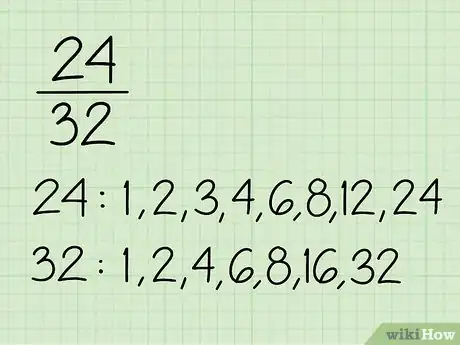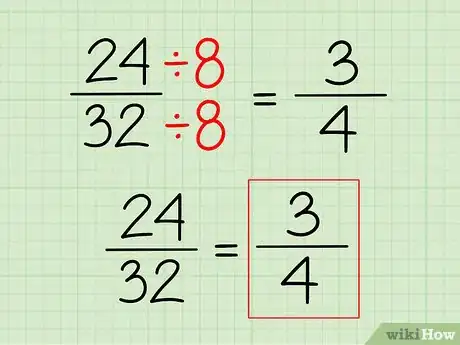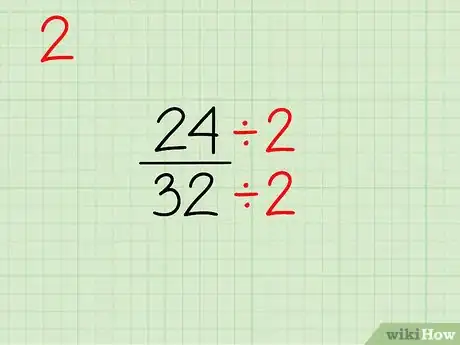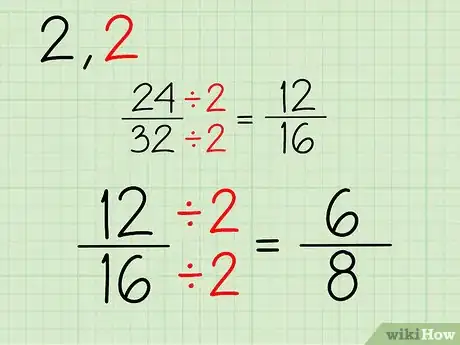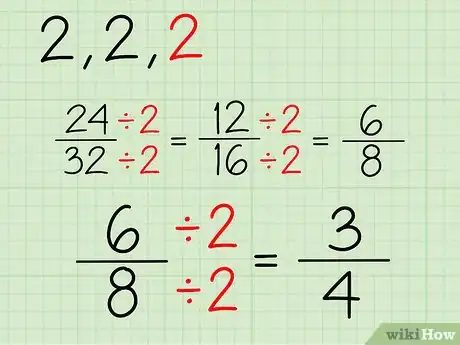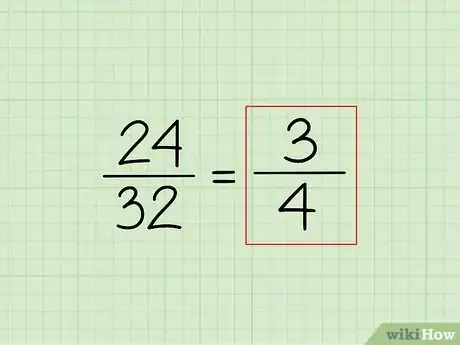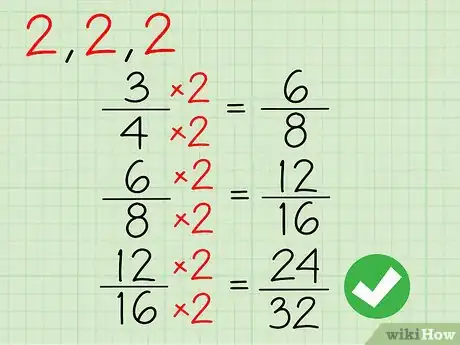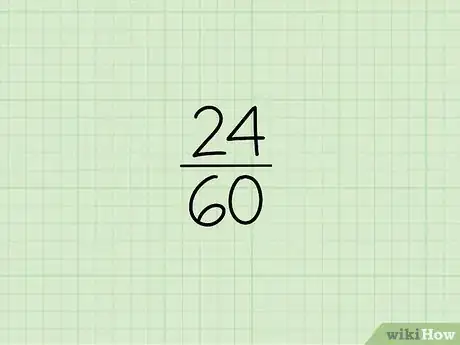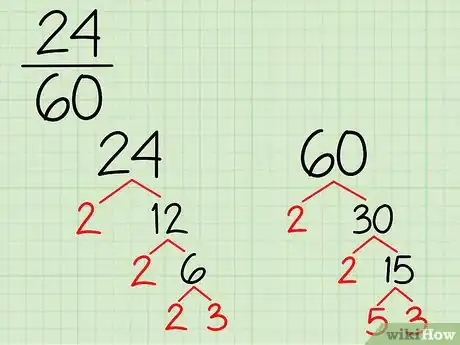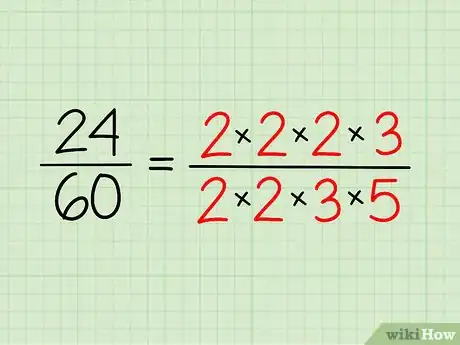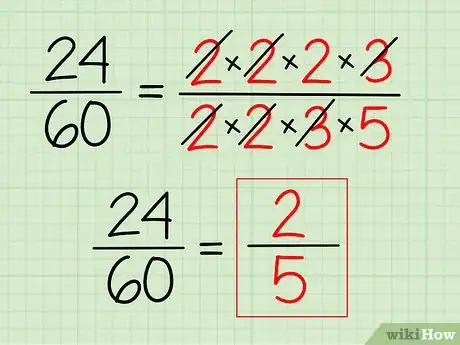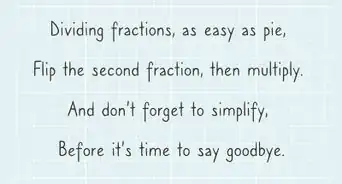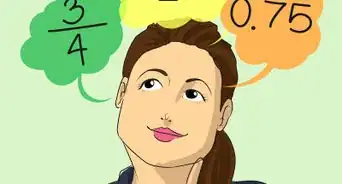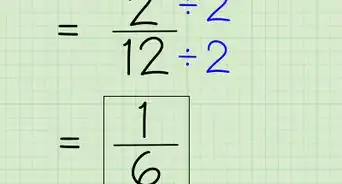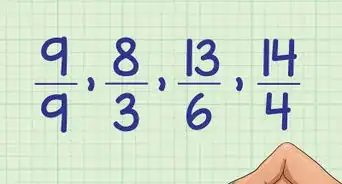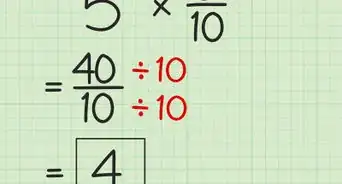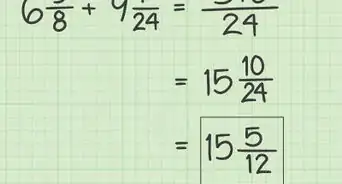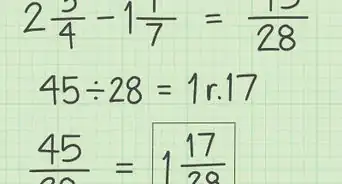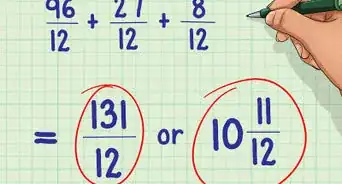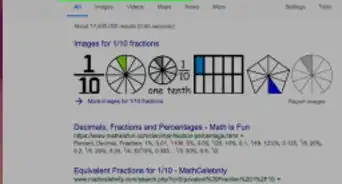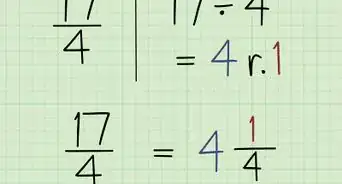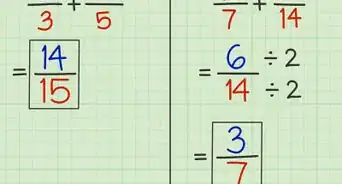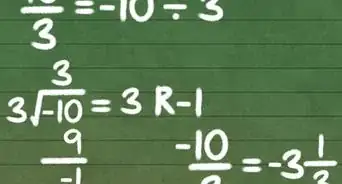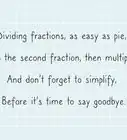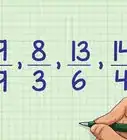This article was co-authored by David Jia. David Jia is an Academic Tutor and the Founder of LA Math Tutoring, a private tutoring company based in Los Angeles, California. With over 10 years of teaching experience, David works with students of all ages and grades in various subjects, as well as college admissions counseling and test preparation for the SAT, ACT, ISEE, and more. After attaining a perfect 800 math score and a 690 English score on the SAT, David was awarded the Dickinson Scholarship from the University of Miami, where he graduated with a Bachelor’s degree in Business Administration. Additionally, David has worked as an instructor for online videos for textbook companies such as Larson Texts, Big Ideas Learning, and Big Ideas Math.
This article has been viewed 208,835 times.
Math is hard. It's easy to forget even core concepts when you are trying to remember dozens of different principles and methods. Here's your refresher on two methods to reduce fractions.
Steps
Using the Greatest Common Factor
-
1List the factors of the numerator and denominator. Factors are numbers that you multiply together to get another number. For example, 3 and 4 are both factors of 12, because you can multiply them together to get 12. To list the factors of a number, you simply have to list all of the numbers that can be multiplied to get that number, and which therefore can be evenly divided into that number.[1]
- List the factors of that number from smallest to largest, not forgetting to include 1 or that number. For example, this is how you would list the factors of the numerator and denominator of the fraction, 24/32:
- 24: 1, 2, 3, 4, 6, 8, 12, 24.
- 32: 1, 2, 4, 8, 16, 32.
- List the factors of that number from smallest to largest, not forgetting to include 1 or that number. For example, this is how you would list the factors of the numerator and denominator of the fraction, 24/32:
-
2Find the greatest common factor (GCF) of the numerator and denominator. The GCF is the highest number that divides evenly into two or more numbers. Once you've listed all of the factors of that number, all you have to do is find the largest number that is repeated in both lists.[2]
- 24: 1, 2, 3, 4, 6, 8, 12, 24.
- 32: 1, 2, 4, 8, 16, 32.
- The GCF of 24 and 32 is 8, because 8 is the largest number that evenly divides into both 24 and 32.
Advertisement -
3Divide the numerator and denominator by the GCF. Now that you've found your GCF, all you have to do is to divide the numerator and denominator by that number to reduce your fraction to its lowest terms. Here's how to do it:[3]
- 24/8 = 3
- 32/8 = 4
- The simplified fraction is 3/4.
-
4Check your work. If you'd like to make sure that you've simplified the fraction correctly, you can simply multiply the new numerator and new denominator by the GCF to make sure that you can return to the original fraction. Here's how to do it:[4]
- 3 * 8 = 24
- 4 * 8 = 32
- You have returned to the original fraction, 24/32.
- You can also examine the fraction to make sure that it cannot be reduced any more. Since 3 is a prime number, it can only be divisible by 1 and itself, and four is not divisible by 3, so the fraction cannot be reduced further.
Keep Dividing by a Small Number
-
1Pick a small number. Using this method, you simply have to choose a small number, such as 2, 3, 4, 5, or 7, to get started. Look at the fractions to make sure that each one is divisible by the number you choose at least once.[5] For example, if you're looking at the fraction 24/108, don't pick the number 5, because it won't go into either number. However, if you're looking at the fraction 25/60, 5 will be a great number to use.
- For the fraction 24/32, the number 2 works well. Since both numbers are even, they will be divisible by 2.
-
2Divide the numerator and denominator of a fraction by that number.[6] The new fraction will be comprised of the new numerator and denominator you get after dividing the top and bottom of the fraction 24/32 by 2. Here's how to do it:
- 24/2 = 12
- 32/2 = 16
- Your new fraction is 12/16.
-
3Repeat. Continue this process. Since both numbers are still even, you can keep dividing them by 2. If just one or both of your new numerators and denominators are odd, then you can try to divide them by a new number. Here's how the process will work if you're sticking with the fraction 12/16:
- 12/2 = 6
- 16/2 = 8
- Your new fraction is 6/8.
-
4Keep dividing by that number until you can't go any further. Both the new numerator and the new denominator are still even, so you can keep dividing them by 2. Here's how to do it:
- 6/2 = 3
- 8/2 = 4
- Your new fraction is 3/4.
-
5Make sure the fraction cannot be reduced further. In the fraction 3/4, 3 is a prime number, so its only factors are 1 and itself, and 4 is not divisible by three, so the fraction has been simplified as much as possible. If the numerator or denominator of the fraction can no longer be divisible by the number you've chosen, you may still be able to divide it by using a new number.[7]
- For example, if you have the fraction 10/40, and are dividing the numerator and denominator by 5, you will be left with 2/8. You cannot keep dividing the numerator and denominator by 5, but you can divide both by 2 to get the final answer of 1/4.
-
6Check your work. Work backwards to multiply 3/4 by 2/2 three times, to make sure that you get the original answer of 24/32. Here's how you do it:
- 3/4 * 2/2 = 6/8
- 6/8 * 2/2 = 12/16
- 12/16 * 2/2 = 24/32.
- Note that you've divided 24/32 by 2 * 2 * 2, which is the same as dividing it by 8, the greatest common factor (GCF) of 24 and 32.
Listing the Factors
-
1Write out your fraction. Leave a large space to the right hand side of your paper -- you'll need it to write out the factors.
-
2List the factors of the numerator and the denominator. Keep them in separate lists. It may be easiest if the lists line up on top of each other. Start with 1 and work your way up, listing them in pairs.
- For example, if your fraction is 24/60, start off with 24.
You'd write: 24 -- 1, 2, 3, 4, 6, 8, 12, 24 - Then, move onto 60.
You'd write: 60 -- 1, 2, 3, 4, 5, 6, 10, 12, 15, 20, 30, 60
- For example, if your fraction is 24/60, start off with 24.
-
3Find and divide by the greatest common factor. This may be referred to as the GCF in your textbook. What's the biggest number that goes into both the numerator and the denominator? Whatever it is, divide both numbers by that.
- For our example, the biggest number that is a factor of both numbers is 12. Therefore, we divide 24 by 12 and 60 by 12, leaving us with 2/5 -- our reduced fraction!
Using Prime Factor Trees
-
1Find the prime factors of the numerator and the denominator. A "prime" number is a number that cannot be divided by any other number and stay whole (apart from itself and 1, of course). 2, 3, 5, 7, and 11 are examples of prime numbers.[8]
- Start with the numerator. From 24, branch off into 2 and 12. Since 2 is a prime number already, you're done with that branch! Then take 12 into two more numbers: 2 and 6. 2 is a prime number -- great! Now divide 6 into two numbers: 2 and 3. You now have 2, 2, 2, and 3 as your prime numbers.
- Move onto the denominator. From 60, branch off your tree to 2 and 30. 30 will then split into 2 and 15. Then split 15 into 3 and 5,both prime. You now have 2, 2, 3 and 5 as your prime numbers.
-
2Write the prime factorization of each number. Take the list of prime numbers you have for each number and write them out to be multiplied. You don't actually have to do the math -- this just makes it easier to see.
- So, for 24, you have 2 x 2 x 2 x 3 = 24.
- For 60, you have 2 x 2 x 3 x 5 = 60
-
3Cancel out the common factors. Any numbers that you see that are part of both numbers can be eliminated. In this case, what we have in common is a pair of twos and a 3. Goodbye!
- What we are left with is 2 and 5 -- or 2/5! The same answer we got with the above method.
- if both numerator and denominator are even numbers, just think of splitting the number in half. keep on doing it to both until they are to small to split any more.
Community Q&A
-
QuestionHow do I reduce a fraction with an odd number?
 DonaganTop AnswererIf either the numerator or the denominator -- or both -- is odd, you will have to find some low, odd number that will divide evenly into both numbers. If you can't do so, the fraction may be irreducible.
DonaganTop AnswererIf either the numerator or the denominator -- or both -- is odd, you will have to find some low, odd number that will divide evenly into both numbers. If you can't do so, the fraction may be irreducible. -
QuestionCan I reduce fractions if the denominator is larger than the numerator?
 DonaganTop AnswererThe fact that a fraction's denominator is larger than its numerator means it's a proper fraction. It has no bearing on whether the fraction can be reduced. A reducible fraction is one whose numerator and denominator are both divisible by the same number.
DonaganTop AnswererThe fact that a fraction's denominator is larger than its numerator means it's a proper fraction. It has no bearing on whether the fraction can be reduced. A reducible fraction is one whose numerator and denominator are both divisible by the same number. -
QuestionCan you give three fractions that are in lower terms than 8/12?
 DonaganTop Answerer8/12 reduces only to 4/6 and 2/3.
DonaganTop Answerer8/12 reduces only to 4/6 and 2/3.
References
- ↑ https://www.mathsisfun.com/greatest-common-factor.html
- ↑ https://www.mathsisfun.com/greatest-common-factor.html
- ↑ https://www.calculatorsoup.com/calculators/math/fractionssimplify.php
- ↑ https://www.calculatorsoup.com/calculators/math/fractionssimplify.php
- ↑ http://www.helpwithfractions.com/math-homework-helper/simplifying-fractions
- ↑ http://www.helpwithfractions.com/math-homework-helper/simplifying-fractions
- ↑ https://www.chilimath.com/lessons/introductory-algebra/simplifying-fractions/
- ↑ https://www.calculatorsoup.com/calculators/math/prime-factors.php
About This Article
To reduce fractions, start by listing the factors of the numerator and denominator, which are numbers that multiply together to make another number. For example, the factors of 12 would be: 1, 2, 3, 4, 6, and 12. Then, find the greatest common factor between the numerator or denominator, which is the largest number that's in both lists of factors. Once you've found the greatest common factor, just divide the numerator and denominator by that number to reduce the fraction to its lowest terms! If you want to learn how to reduce fractions using prime factor trees, keep reading!
